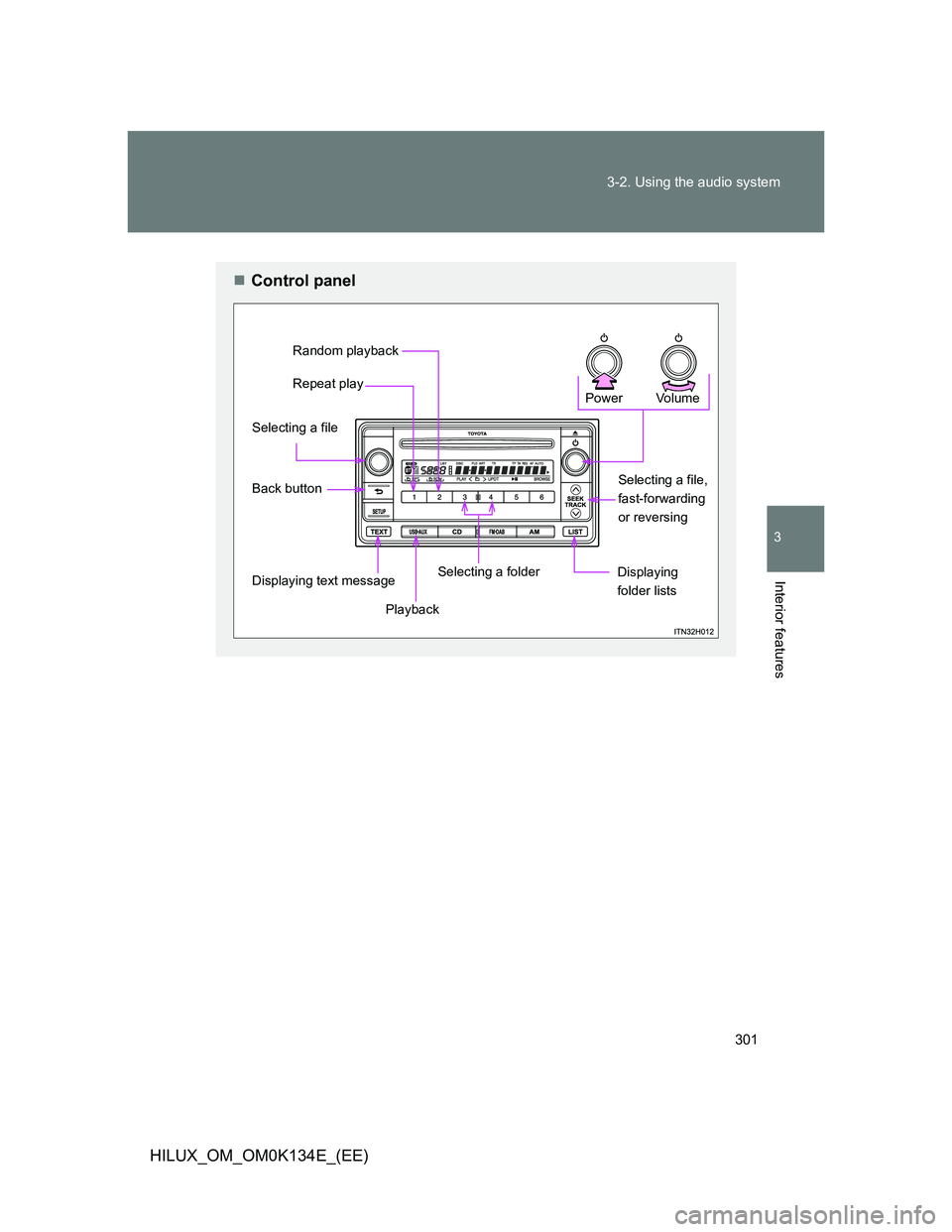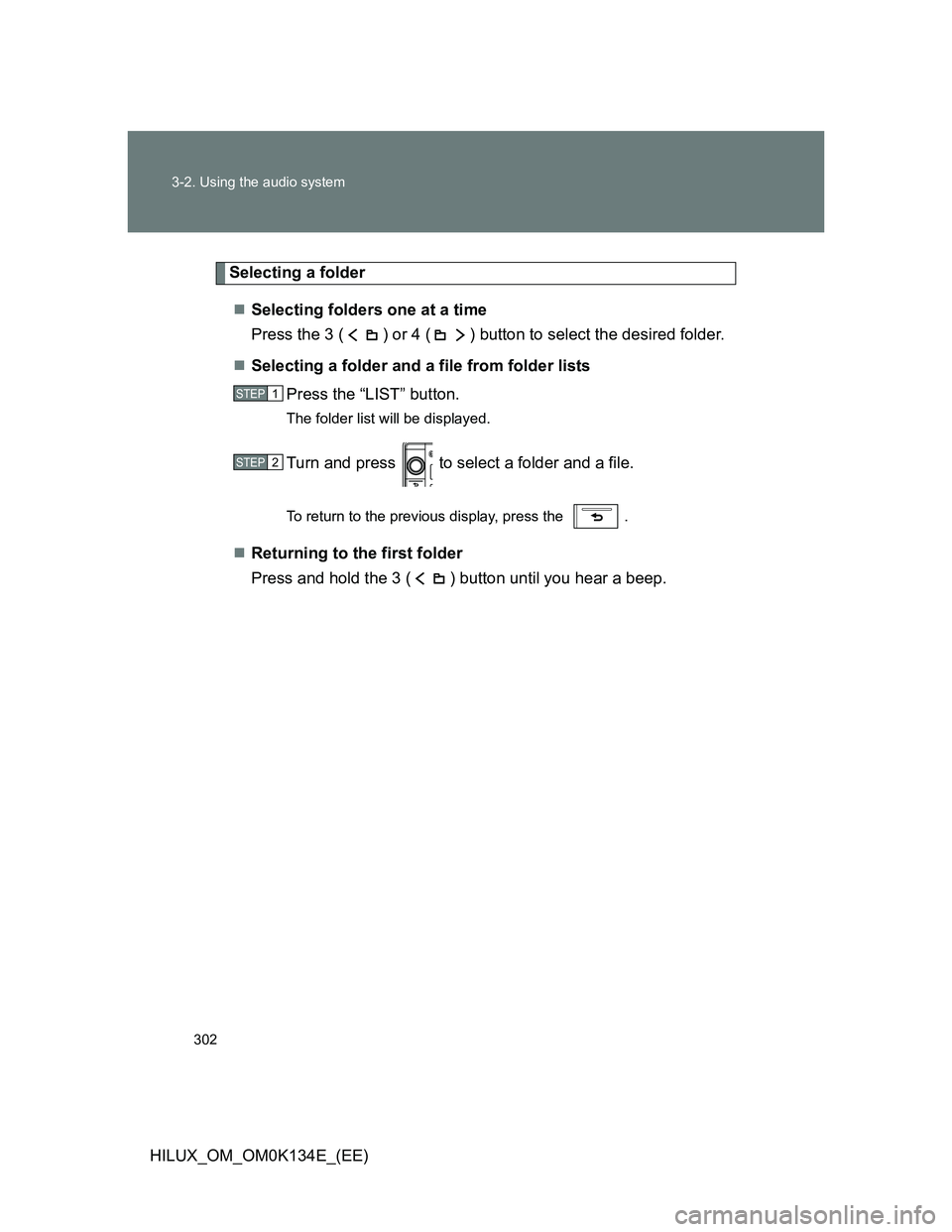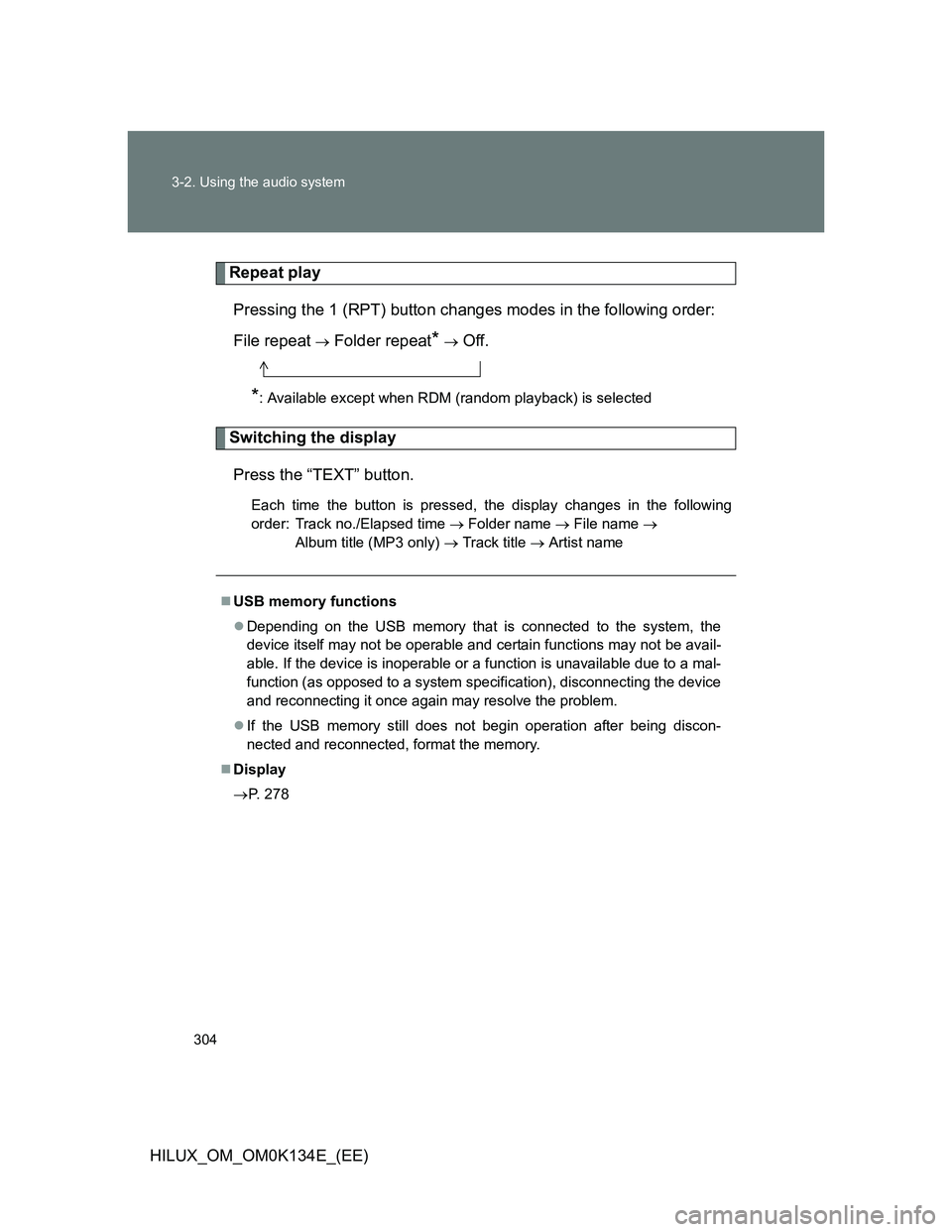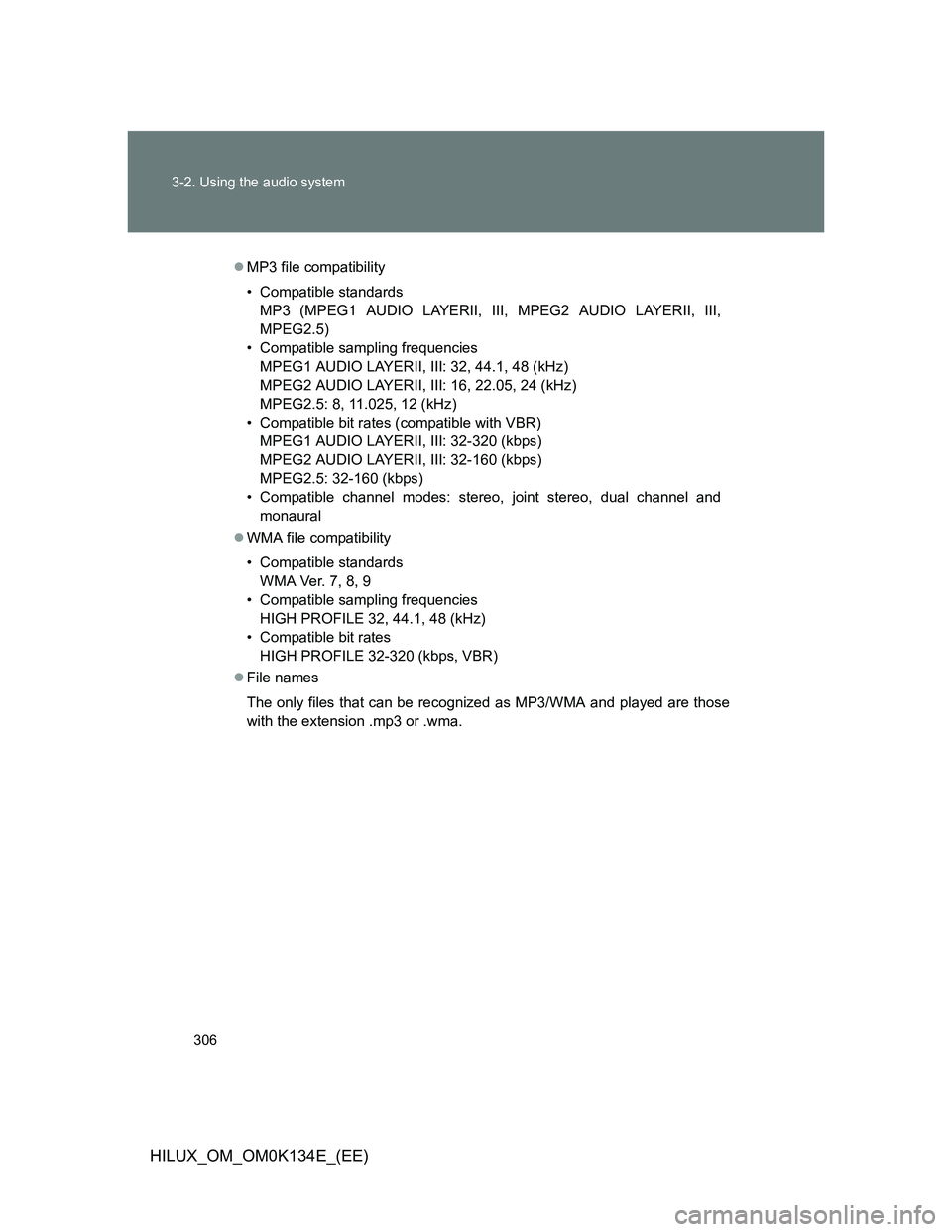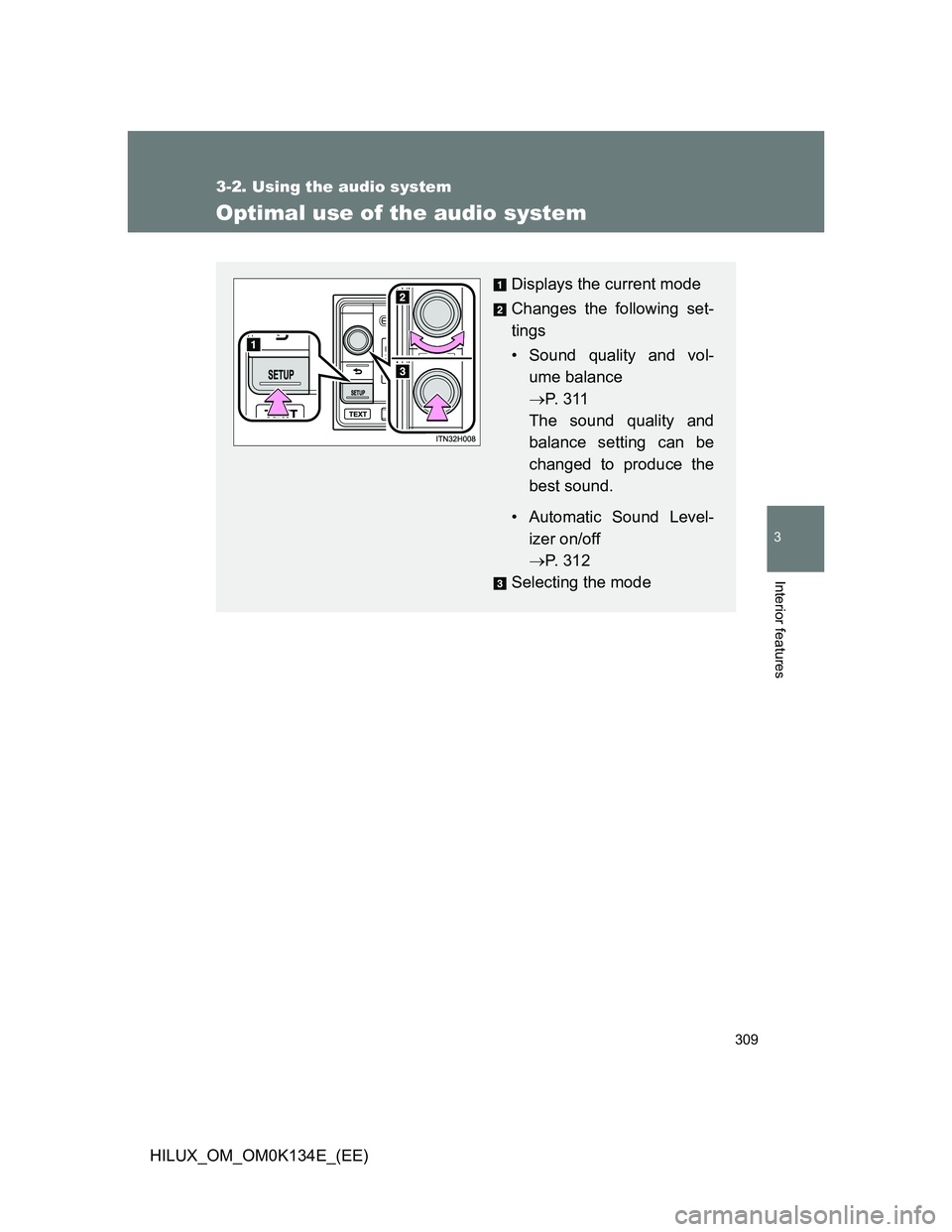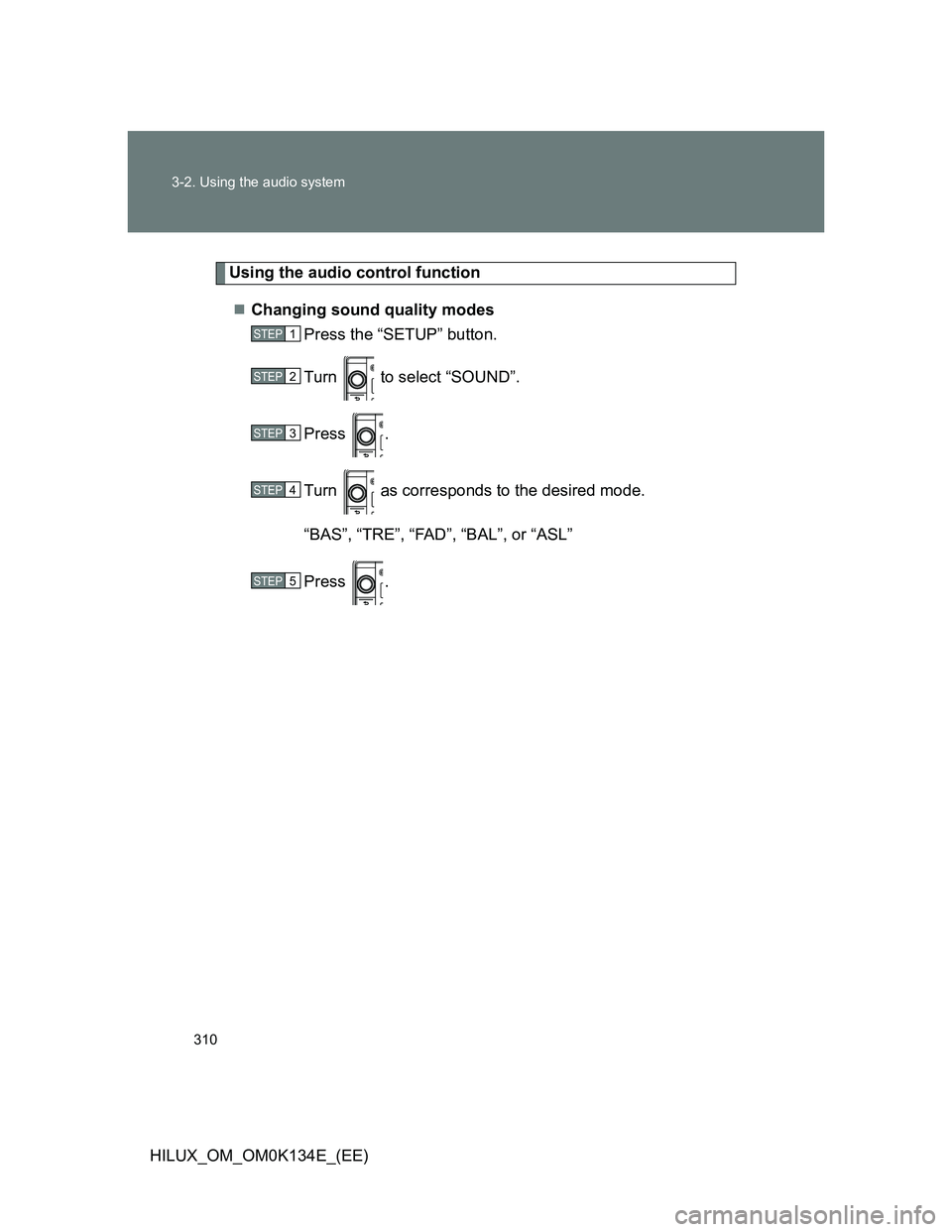TOYOTA HILUX 2013 Owners Manual (in English)
HILUX 2013
TOYOTA
TOYOTA
https://www.carmanualsonline.info/img/14/48585/w960_48585-0.png
TOYOTA HILUX 2013 Owners Manual (in English)
Trending: parking brake, heater, fuel filter, wheel, oil temperature, transmission oil, tire size
Page 301 of 644
301 3-2. Using the audio system
3
Interior features
HILUX_OM_OM0K134E_(EE)
Control panel
Vo lu m e Power
Displaying
folder lists
Playback
Displaying text message
Back button Selecting a file
Repeat play Random playback
Selecting a file,
fast-forwarding
or reversing
Selecting a folder
Page 302 of 644
302 3-2. Using the audio system
HILUX_OM_OM0K134E_(EE)
Selecting a folder
Selecting folders one at a time
Press the 3 ( ) or 4 ( ) button to select the desired folder.
Selecting a folder and a file from folder lists
Press the “LIST” button.
The folder list will be displayed.
Turn and press to select a folder and a file.
To return to the previous display, press the .
Returning to the first folder
Press and hold the 3 ( ) button until you hear a beep.
STEP1
STEP2
Page 303 of 644
303 3-2. Using the audio system
3
Interior features
HILUX_OM_OM0K134E_(EE)
Selecting files
Turn or press “” or “” on the “SEEK/TRACK” button to select
the desired file.
Fast-forwarding and rewinding files
To fast-forward or rewind, press and hold “” or “” on the “SEEK/
TRACK” button.
Random playback
Pressing the 2 (RDM) button changes modes in the following order:
Folder random Disc random Off.
Page 304 of 644
304 3-2. Using the audio system
HILUX_OM_OM0K134E_(EE)
Repeat play
Pressing the 1 (RPT) button changes modes in the following order:
File repeat
Folder repeat* Off.
*: Available except when RDM (random playback) is selected
Switching the display
Press the “TEXT” button.
Each time the button is pressed, the display changes in the following
order: Track no./Elapsed time Folder name File name
Album title (MP3 only) Track title Artist name
USB memory functions
Depending on the USB memory that is connected to the system, the
device itself may not be operable and certain functions may not be avail-
able. If the device is inoperable or a function is unavailable due to a mal-
function (as opposed to a system specification), disconnecting the device
and reconnecting it once again may resolve the problem.
If the USB memory still does not begin operation after being discon-
nected and reconnected, format the memory.
Display
P. 278
Page 305 of 644
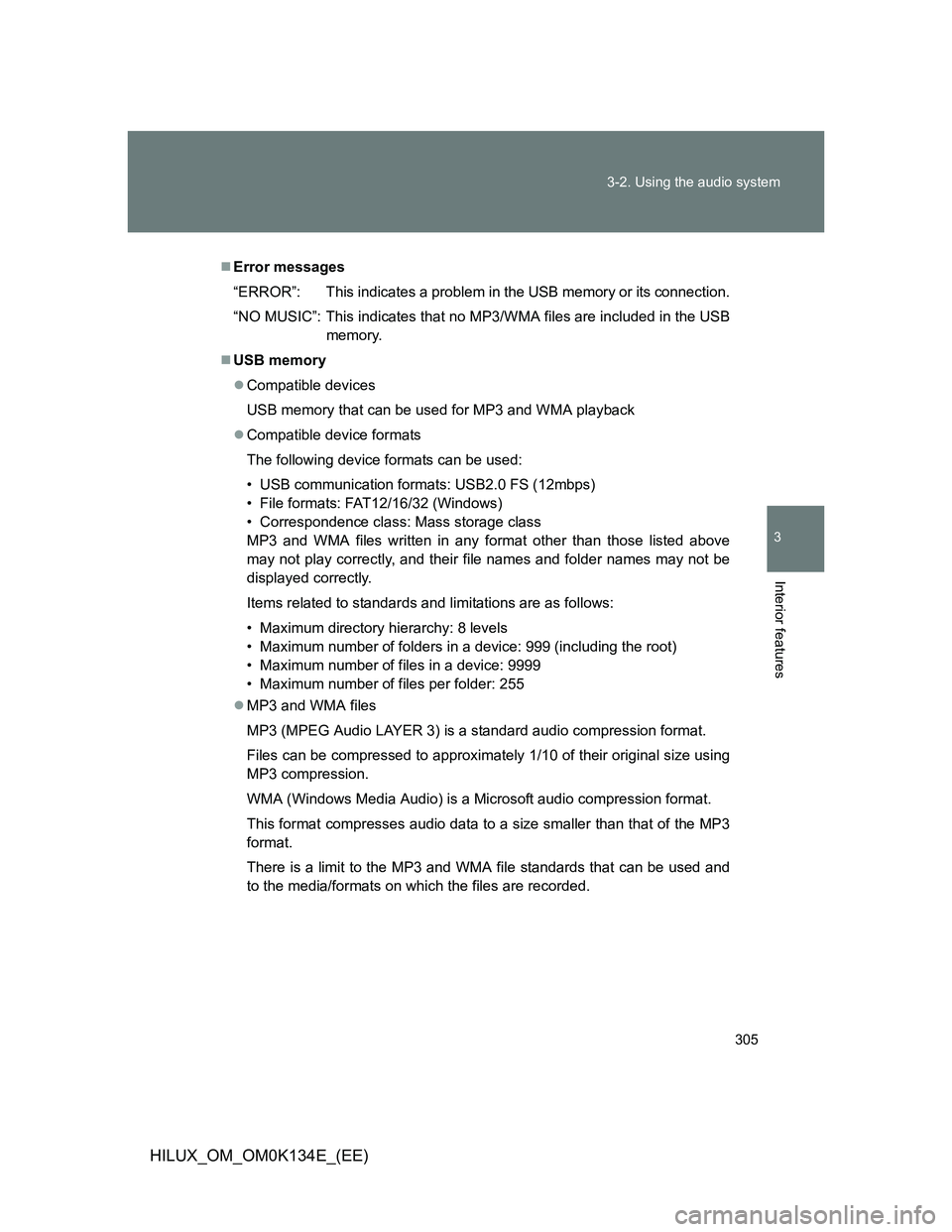
305 3-2. Using the audio system
3
Interior features
HILUX_OM_OM0K134E_(EE)
Error messages
“ERROR”: This indicates a problem in the USB memory or its connection.
“NO MUSIC”: This indicates that no MP3/WMA files are included in the USB
memory.
USB memory
Compatible devices
USB memory that can be used for MP3 and WMA playback
Compatible device formats
The following device formats can be used:
• USB communication formats: USB2.0 FS (12mbps)
• File formats: FAT12/16/32 (Windows)
• Correspondence class: Mass storage class
MP3 and WMA files written in any format other than those listed above
may not play correctly, and their file names and folder names may not be
displayed correctly.
Items related to standards and limitations are as follows:
• Maximum directory hierarchy: 8 levels
• Maximum number of folders in a device: 999 (including the root)
• Maximum number of files in a device: 9999
• Maximum number of files per folder: 255
MP3 and WMA files
MP3 (MPEG Audio LAYER 3) is a standard audio compression format.
Files can be compressed to approximately 1/10 of their original size using
MP3 compression.
WMA (Windows Media Audio) is a Microsoft audio compression format.
This format compresses audio data to a size smaller than that of the MP3
format.
There is a limit to the MP3 and WMA file standards that can be used and
to the media/formats on which the files are recorded.
Page 306 of 644
306 3-2. Using the audio system
HILUX_OM_OM0K134E_(EE)
MP3 file compatibility
• Compatible standards
MP3 (MPEG1 AUDIO LAYERII, III, MPEG2 AUDIO LAYERII, III,
MPEG2.5)
• Compatible sampling frequencies
MPEG1 AUDIO LAYERII, III: 32, 44.1, 48 (kHz)
MPEG2 AUDIO LAYERII, III: 16, 22.05, 24 (kHz)
MPEG2.5: 8, 11.025, 12 (kHz)
• Compatible bit rates (compatible with VBR)
MPEG1 AUDIO LAYERII, III: 32-320 (kbps)
MPEG2 AUDIO LAYERII, III: 32-160 (kbps)
MPEG2.5: 32-160 (kbps)
• Compatible channel modes: stereo, joint stereo, dual channel and
monaural
WMA file compatibility
• Compatible standards
WMA Ver. 7, 8, 9
• Compatible sampling frequencies
HIGH PROFILE 32, 44.1, 48 (kHz)
• Compatible bit rates
HIGH PROFILE 32-320 (kbps, VBR)
File names
The only files that can be recognized as MP3/WMA and played are those
with the extension .mp3 or .wma.
Page 307 of 644

307 3-2. Using the audio system
3
Interior features
HILUX_OM_OM0K134E_(EE)
ID3 and WMA tags
ID3 tags can be added to MP3 files, making it possible to record the track
title, artist name, etc.
The system is compatible with ID3 Ver. 1.0, 1.1, and Ver. 2.2, 2.3, 2.4 ID3
tags. (The number of characters is based on ID3 Ver. 1.0 and 1.1.)
WMA tags can be added to WMA files, making it possible to record the
track title and artist name in the same way as with ID3 tags.
MP3 and WMA playback
• When a device containing MP3 or WMA files is connected, all files in
the USB memory device are checked. Once the file check is finished,
the first MP3 or WMA file is played. To make the file check finish more
quickly, we recommend that you do not include any files other than
MP3 or WMA files or create any unnecessary folders.
• When the USB device is connected and the audio source is changed to
USB memory mode, the USB device will start playing the first file in the
first folder. If the same device is removed and reinserted (and the con-
tents have not been changed), the USB device will resume play from
the same point in which it was last used.
Extensions
If the file extensions .mp3 and .wma are used for files other than MP3 and
WMA files, they will be skipped (not played).
Page 308 of 644
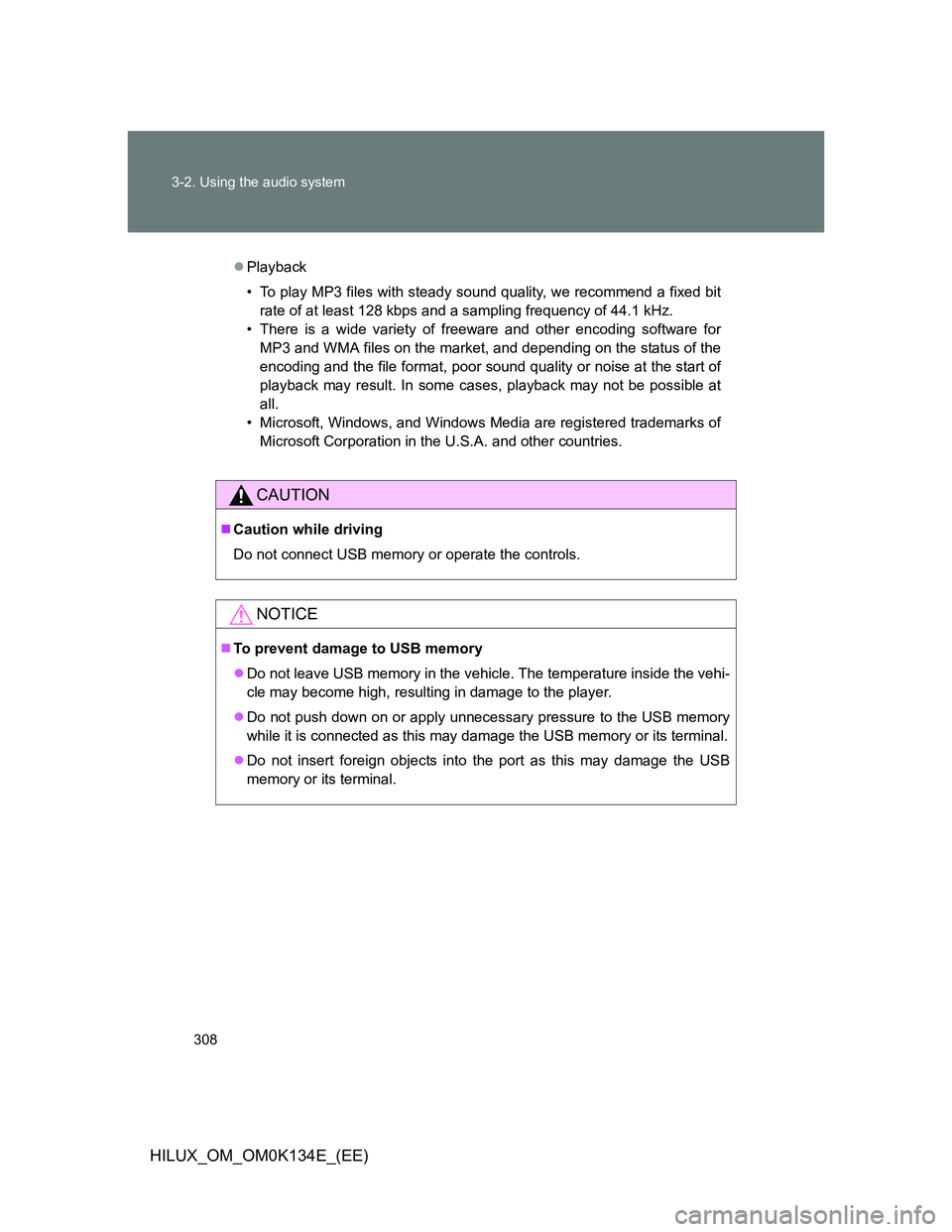
308 3-2. Using the audio system
HILUX_OM_OM0K134E_(EE)
Playback
• To play MP3 files with steady sound quality, we recommend a fixed bit
rate of at least 128 kbps and a sampling frequency of 44.1 kHz.
• There is a wide variety of freeware and other encoding software for
MP3 and WMA files on the market, and depending on the status of the
encoding and the file format, poor sound quality or noise at the start of
playback may result. In some cases, playback may not be possible at
all.
• Microsoft, Windows, and Windows Media are registered trademarks of
Microsoft Corporation in the U.S.A. and other countries.
CAUTION
Caution while driving
Do not connect USB memory or operate the controls.
NOTICE
To prevent damage to USB memory
Do not leave USB memory in the vehicle. The temperature inside the vehi-
cle may become high, resulting in damage to the player.
Do not push down on or apply unnecessary pressure to the USB memory
while it is connected as this may damage the USB memory or its terminal.
Do not insert foreign objects into the port as this may damage the USB
memory or its terminal.
Page 309 of 644
309
3-2. Using the audio system
3
Interior features
HILUX_OM_OM0K134E_(EE)
Optimal use of the audio system
Displays the current mode
Changes the following set-
tings
• Sound quality and vol-
ume balance
P. 3 1 1
The sound quality and
balance setting can be
changed to produce the
best sound.
• Automatic Sound Level-
izer on/off
P. 3 1 2
Selecting the mode
Page 310 of 644
310 3-2. Using the audio system
HILUX_OM_OM0K134E_(EE)
Using the audio control function
Changing sound quality modes
Press the “SETUP” button.
Turn to select “SOUND”.
Press .
Turn as corresponds to the desired mode.
“BAS”, “TRE”, “FAD”, “BAL”, or “ASL”
Press .
STEP1
STEP2
STEP3
STEP4
STEP5
Trending: service schedule, oil pressure, fuse box, cruise control, brake, automatic transmission, clock
